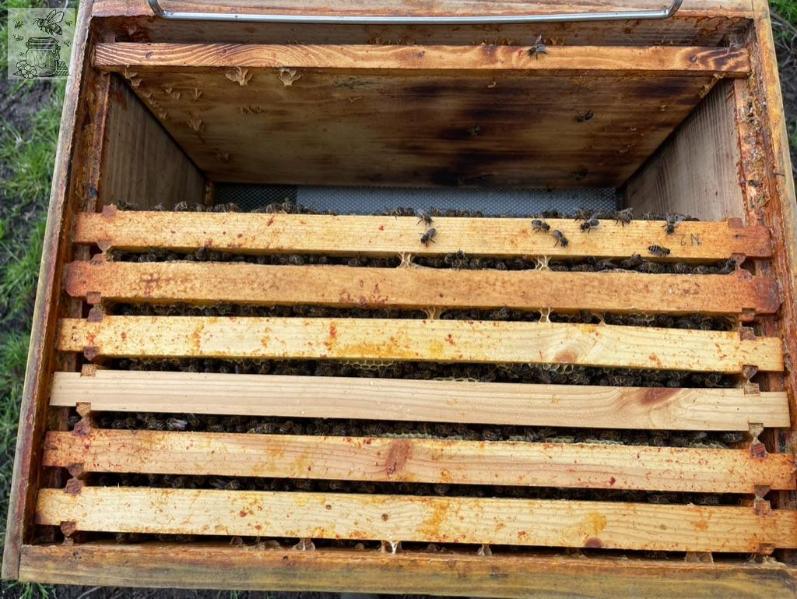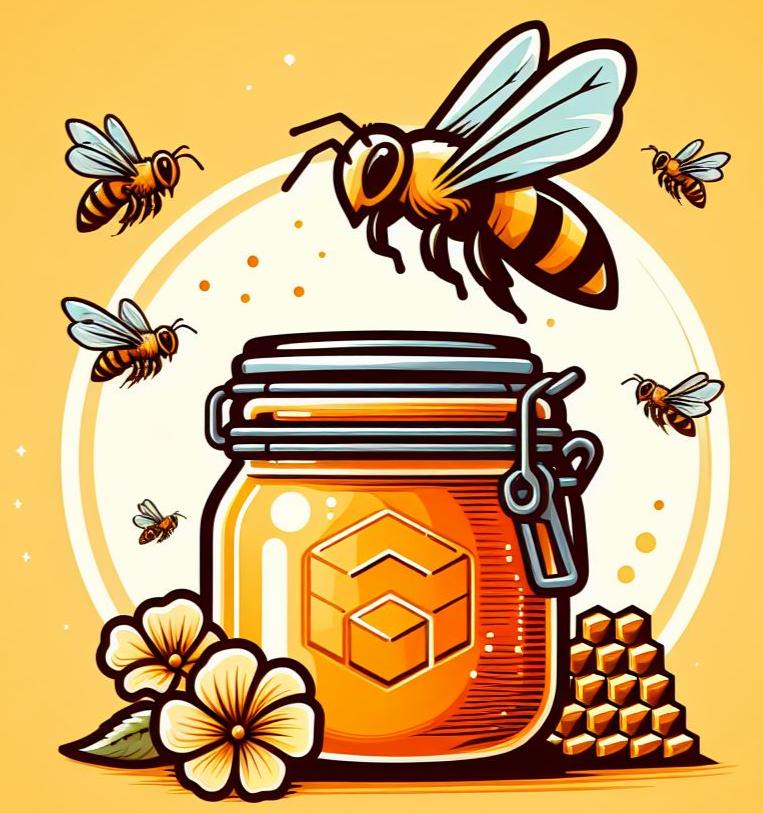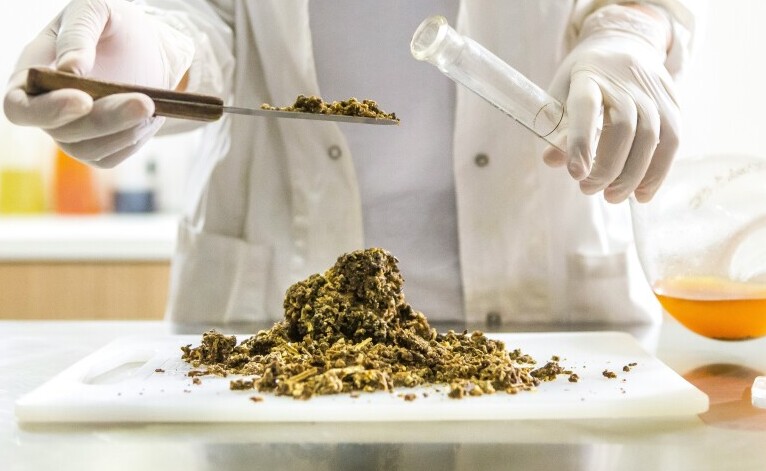Propolis might not be as famous as honey, but it’s definitely a powerhouse in its own right, and my go-to № 1 product in many cases. I buy some of them and I also make and use my home made products, and I will share some tested recipes.
WHAT EXACTLY IS PROPOLIS?
Propolis, often referred to as “bee glue,” is a resinous substance that bees collect from various plants, primarily from buds and tree exudates. Bees use propolis as a construction and maintenance material within the hive, particularly for sealing cracks, reinforcing the hive structure, and protecting the colony from microbial threats. The name actually comes from Greek: ‘pro’ (before) and ‘polis’ (city), basically meaning ‘defender of the city’.
Chemical Composition of Propolis
Propolis is a complex mixture containing more than 300 compounds, and its exact composition can vary significantly depending on the geographical location. Factors like local flora, climate, and even the specific bee species affect its makeup. For instance, propolis from Europe can have different dominant components compared to propolis from South America. In general the primary components of propolis include:
- Resins and Balsams (50-60%): Comprising phenolic compounds and flavonoids such as flavones, flavonols, and flavanones, which are known for their antioxidant properties.
- Beeswax (30-40%): A mixture of long-chain aliphatic hydrocarbons, free fatty acids, esters, and other organic compounds.
- Essential Oils (5-10%): These oils contain aromatic compounds like cinnamic acid, vanillin, and others, contributing to the characteristic smell of propolis.
- Pollen (5%): Added by bees as a source of protein.
- Organic Compounds: Including vitamins (B1, B2, B6, C, and E), amino acids, and enzymes.
Colour and Smell of Propolis
- Colour: propolis can vary in color, ranging from yellow, green, red, and brown to black, depending on its botanical origin. The most common colors are brown and greenish-brown (one of the most popular being brazilian green propolis).
- Smell: propolis has a distinctive, aromatic odor that is often described as a combination of honey, resin, and vanilla, with a slightly balsamic undertone. The smell can vary based on the plant sources from which it was collected.
Density and Physical Forms
- Density: the density of propolis typically ranges between 1.2 to 1.35 g/cm³. It is a sticky, wax-like material that becomes more brittle and harder when exposed to cooler temperatures.
- Forms:
- Raw Propolis: directly collected from hives; usually in the form of small, sticky lumps or chunks.
- Propolis Extracts: available in various forms such as tinctures, pastes, ointments, powders, and capsules. These extracts are typically alcohol-based or water-based.
- Propolis Resin: soft and pliable at room temperature, used directly or as a raw ingredient in health products.
How Bees Collect Propolis
Worker bees collect propolis by scraping resin from tree buds, sap flows, or other botanical sources using their mandibles. They then pack this resin into their pollen baskets, known as “corbiculae,” located on their hind legs. After returning to the hive, the collected material is processed and mixed with beeswax and salivary secretions to create the final product. This task is typically performed by older worker bees who have more experience navigating and processing different materials.
Main Purpose of Propolis in the Hive
- Structural Reinforcement: bees use propolis to strengthen the hive structure, filling in small gaps (those larger than 2-3 mm are typically filled with beeswax instead). This fortification helps maintain the hive’s integrity and prevent drafts. If you ever tried to open a hive, you have definitely experienced how difficult it is sometimes as the parts of the hive are as if “glued” together, and moving frames out can be a bit of a challenge sometimes. A beekeeper cannot really do without the main tools!
- Antimicrobial Barrier: propolis has strong antimicrobial properties, which bees use to protect the hive from infections by bacteria, viruses, and fungi. It creates a barrier that inhibits the growth of pathogens, contributing to the overall health of the colony.
- Hive Hygiene: propolis is used to coat the interior surfaces of the hive, creating a sterile environment. It is also employed to “mummify” intruders that are too large to be removed, preventing decay and contamination.
- Thermoregulation: by sealing cracks and crevices, propolis helps regulate the internal temperature and humidity of the hive, ensuring a stable environment for the bees.

In this photo you can see a dense looking brown substance connecting the side ends of each frames to the brood box.
In warm weather it is sticky and pliable, and when it is cold it is brittle, so when the frames are pried apart, there is quite a loud “cracking” noise.
PROPOLIS BENEFITS and SIDE EFFECTS
Humans have been using propolis for centuries. Ancient Egyptians, Greeks, and Romans all took advantage of its unique properties. The Egyptians used it for mummification, thanks to its antibacterial qualities. Greeks used it for treating abscesses, and the Romans recognized its healing properties for wounds.
Understanding why propolis has been so valued throughout history helps us appreciate its potential benefits today. Modern science is catching up to these age-old practices, examining the complex mix of compounds found in propolis and how they contribute to its health benefits.
Health Benefits: Propolis is Nature’s Treasure
From boosting your immune system to its antibacterial properties and its role in skincare — propolis might just be the natural remedy you’ve been looking for in maintaining good health.
PROPOLIS AND ITS NUTRITIONAL PROFILE
Propolis is packed with a diverse array of nutrients that make it a unique addition to your wellness routine. It’s rich in vitamins like B1, B2, B6, C, and E, providing essential support for various bodily functions. It contains such minerals such as magnesium, calcium, potassium, and zinc. These minerals are crucial for everything from bone health to immune function.
Flavonoids are another significant component of propolis. These powerful antioxidants help protect cells from damage and support overall health. The amino acids present in propolis further enhance its nutritional profile, they help in protein synthesis and muscle repair.
When comparing propolis to other bee products, it’s clear that each has its own unique benefits. Honey is known for its soothing and energy-boosting properties, while royal jelly is prized for its potential to improve skin health and vitality. Propolis stands out for its potent immune-boosting and antibacterial properties.
IMMUNE SYSTEM BOOST
Propolis can be a valuable asset in strengthening the immune system. Its rich blend of bioactive compounds plays a vital role in enhancing your body’s natural defenses. The unique combination of flavonoids, phenolic acids, and other antioxidants works collectively to bolster immunity.
Scientific research supports the immune-boosting claims of propolis. Studies have shown that propolis can stimulate the production of antibodies, enhancing the body’s ability to fight off infections. It helps modulate the immune system, ensuring it responds appropriately to various threats without becoming overactive or underactive.
Many people have shared their positive experiences with propolis. Some have found that regular propolis supplementation helps reduce colds and other minor infections. Others believe it helps them recover more quickly when they do fall sick.
THE ANTIBACTERIAL POWER OF PROPOLIS
Propolis REALLY shines when it comes to its antibacterial properties. It has actually earned the nickname ‘nature’s antibiotic’ due to its strong antibacterial properties. Unlike synthetic antibiotics, which often target specific bacterial strains, propolis has a broad-spectrum antibacterial effect. It works against a wide range of pathogens, making it a versatile and effective natural remedy. It’s like nature’s own disinfectant, working to keep harmful bacteria at bay. The high levels of flavonoids and phenolic compounds in propolis play a critical role in this, disrupting the cellular structure of bacteria and inhibiting their growth.
There has been quite a substantial research that has highlighted the effectiveness of propolis against a wide range of bacterial strains. One of the significant advantages of using propolis over synthetic antibiotics is the reduced likelihood of developing antibiotic resistance. Bacteria can quickly adapt and become resistant to synthetic drugs, but the complex chemical nature of propolis makes it harder for pathogens to develop resistance.
Practical applications of propolis for its antibacterial benefits are numerous. It can be used in topical creams to help treat cuts and wounds, minimizing the risk of infection. Many people also use propolis throat sprays and lozenges to help alleviate sore throats and oral infections. Propolis-infused mouthwash can help maintain oral health by targeting bacteria that cause plaque and gum disease.
HEALING PROPERTIES OF PROPOLIS
Propolis isn’t just about fighting infections; it’s also a potent healing agent. Thanks to its anti-inflammatory and wound-healing properties, propolis can aid in treating various skin conditions and promoting overall skin health. Its ability to reduce inflammation comes from the valuable compounds like flavonoids and phenolic acids, which block the pathways that lead to inflammation and swelling.
One common use of propolis is for treating minor wounds, burns, and cuts. It not only speeds up the healing process but also provides a protective barrier against infections. Some studies have shown that propolis can be just as effective as traditional wound care methods, if not more. When applied to wounds, propolis forms a thin layer that shields the area from bacterial invasion while promoting tissue regeneration.
Skin conditions such as eczema and psoriasis, which are often driven by inflammation, can also benefit from propolis. Its anti-inflammatory properties help in soothing irritated skin and reducing the symptoms associated with these conditions. There are suggestions that propolis can support collagen production, making it a valuable component in anti-aging skincare formulations.
There is some research and clinical evidence that support these uses. For example, some trials have shown that propolis can significantly improve the healing rate of cold sores and reduce their recurrence.
SOOTHING EFFECT: PROPOLIS IN SKIN CARE
Propolis isn’t just beneficial for your immune system and fighting bacteria; it’s also a fantastic addition to your skincare routine. The anti-inflammatory and antioxidant properties of propolis make it a natural choice for promoting healthy skin.
Research has shown that propolis can aid in healing minor burns, acne, and other skin irritations. Its ability to accelerate cell growth and repair means wounds heal faster, and scars can be minimized. These benefits make propolis a popular ingredient in many skincare products, from creams to serums.
Incorporating propolis into your skincare routine can be simple. There are propolis-infused facial masks, moisturisers, and serums. These products harness the power of propolis to soothe irritated skin, reduce redness, and offer deep hydration.
Many users have reported noticeable improvements in their skin texture and appearance after introducing propolis-based products into their regimen. It’s particularly beneficial for those with sensitive skin or conditions like eczema and rosacea, offering a gentle yet effective solution.
When selecting propolis skincare products, quality matters. Opt for those with transparent ingredient lists and avoid products with unnecessary additives or chemicals. Consulting a dermatologist can provide personalized advice on how to best use propolis for your unique skin needs.
Contraindications and Considerations for Safe Use
Propolis is undoubtedly beneficial, but it’s important to use it wisely. Like any natural remedy, it comes with potential side effects and considerations. Some individuals may experience allergic reactions, particularly those who are allergic to bee products or have asthma.
Potential side effects include skin irritation, especially when using propolis topically for the first time. Internally, propolis can cause gastrointestinal discomfort in some people. If you’re pregnant, breastfeeding, or have a serious health condition, it’s always best to consult with a healthcare provider before starting any new supplement.
Proper dosage is another key factor. While there isn’t a standardised dosage for propolis, starting with small amounts can help gauge your body’s response. Product labels usually provide recommended dosages.
Quality and source matter when selecting propolis products. Choose reputable brands that provide detailed information about sourcing and production. Organic or sustainably sourced products can also be a better choice to avoid contaminants.
Using propolis responsibly ensures you can enjoy its benefits while minimising risks. Always pay attention to how your body reacts, and don’t hesitate to seek professional advice of an apitherapist, if you experience any adverse effects.

